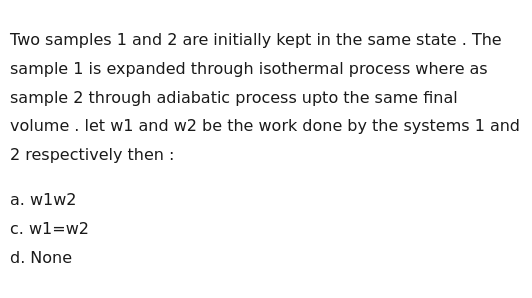Question
Question: Two samples 1 and 2 are initially kept in the same state . The sample 1 is expanded through isotherm...
Two samples 1 and 2 are initially kept in the same state . The sample 1 is expanded through isothermal process where as sample 2 through adiabatic process upto the same final volume . let w1 and w2 be the work done by the systems 1 and 2 respectively then :

w1<w2
w1>w2
w1=w2
None
w1>w2
Solution
Let the initial state of both samples be (P1,V1). Both samples expand to the same final volume V2, where V2>V1.
For sample 1, the process is isothermal. The equation of state is PV=constant. Let the final state be (P2,iso,V2). The work done by the system during isothermal expansion is given by: W1=∫V1V2PdV Since PV=P1V1, we have P=VP1V1. W1=∫V1V2VP1V1dV=P1V1∫V1V2V1dV=P1V1[lnV]V1V2=P1V1ln(V1V2). Alternatively, using the ideal gas law P1V1=nRT1 (where T1 is the constant temperature), W1=nRT1ln(V1V2). Since V2>V1, ln(V2/V1)>0, so W1>0.
For sample 2, the process is adiabatic. The equation of state is PVγ=constant, where γ=Cp/Cv>1. Let the final state be (P2,adi,V2). The work done by the system during adiabatic expansion is given by: W2=∫V1V2PdV Since PVγ=P1V1γ, we have P=VγP1V1γ. W2=∫V1V2VγP1V1γdV=P1V1γ∫V1V2V−γdV=P1V1γ[−γ+1V−γ+1]V1V2=1−γP1V1γ(V21−γ−V11−γ). W2=1−γP1V1γV11−γ((V1V2)1−γ−1)=1−γP1V1((V1V2)1−γ−1). Since γ>1, 1−γ<0. Let 1−γ=−α where α=γ−1>0. W2=−αP1V1((V1V2)−α−1)=αP1V1(1−(V2V1)α)=γ−1P1V1(1−(V2V1)γ−1). Since V2>V1, V1/V2<1, so (V1/V2)γ−1<1. Thus, 1−(V1/V2)γ−1>0, and W2>0.
To compare W1 and W2, we can consider the P-V diagram. Both processes start at the same point (P1,V1) and expand to the same final volume V2. The work done is the area under the curve on the P-V diagram. For V>V1, the pressure in the isothermal process is Piso(V)=P1VV1. For V>V1, the pressure in the adiabatic process is Padi(V)=P1(VV1)γ. Since V2>V≥V1 and γ>1, we have VV1≤1 and (VV1)γ≤VV1. Thus, Padi(V)≤Piso(V) for V≥V1. For V>V1, Padi(V)<Piso(V). This means the isothermal curve lies above the adiabatic curve for V>V1. Since the work done is the area under the curve ∫V1V2PdV, and Piso(V)>Padi(V) for V1<V≤V2, the area under the isothermal curve is greater than the area under the adiabatic curve. Therefore, W1=Wiso>Wadi=W2.
The relationship between W1 and W2 is W1>W2.
Explanation:
Work done by a system during expansion is the area under the pressure-volume (P-V) curve. For expansion from the same initial state to the same final volume, the isothermal process curve (PV=constant) lies above the adiabatic process curve (PVγ=constant, where γ>1) on the P-V diagram for V>V1. This is because pressure drops faster in an adiabatic expansion than in an isothermal expansion. Consequently, the area under the isothermal curve (W1) is greater than the area under the adiabatic curve (W2). Therefore, W1>W2.
